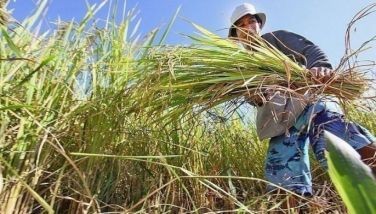Naked chicken, anyone?
July 14, 2002 | 12:00am
Scientists from Israel’s Hebrew University have developed what is now known as "naked" chicken or chicken with no feathers. A wire story by Reuters news agency described the featherless chicken as "looking a little ridiculous" but is supposedly low-fat and succulent. It is also environment-friendly with no feathers to be plucked and disposed of later.
The meant of the red-skinned chicken is also said to be "leaner" and, therefore, healtier than the meat of the feathered variety.
There is no word yet when the featherless bird would be available commercially. This early, though, indications are that the naked chicken may become the darling of the poultry industry, not only because of its uniqueness but also due to the savings – and subsequent profits – it could bring to the poultry business.
With no feathers to grow, this type of chicken is expected to optimally use the feed it consumes in the development of its meat content.
Feathers comprise about 6 percent of the total body weight of a mature chicken.
According to Dr. Ariel Carlos, a noted Filipino animal nutrionists:
"Since feathers are approximately 80 percent protein, the feed component that goes to the growth of feathers extrapolated from the protein component of the feed consumed by the bird."
Dr. Carlos volunteers that a mature 45-day old broiler consumes 3.4 kilos of feeds and should weigh at least 1.7 kilos live.
Sans feathers, chicken are expected to grow bigger, and faster. Less mortality is another anticipated benefit as high chicken death is attributed to heat. Poultry operators invest a fortune in keeping poultry farms cool and well-ventilated.
There are drawbacks, though, in raising naked chicken, according to Dr. Kelly Viado, technical services manager of General Milling Corp. (GMC), one of the country’s largest feeds manufacturer.
"Feathers protect the skin from injury and possible harmful effects of matters in the poultry environment. Without feathers, the chicken’s skin may get injured and get rejected in the dresing plant."
While households usually just throw away plucked feathers, commercial poultry farms convert these to other uses. Together with other poultry by-products such as the head,neck and internal organs, feathers are processed into feed ingredients. – PAJ News & Features
The meant of the red-skinned chicken is also said to be "leaner" and, therefore, healtier than the meat of the feathered variety.
There is no word yet when the featherless bird would be available commercially. This early, though, indications are that the naked chicken may become the darling of the poultry industry, not only because of its uniqueness but also due to the savings – and subsequent profits – it could bring to the poultry business.
With no feathers to grow, this type of chicken is expected to optimally use the feed it consumes in the development of its meat content.
Feathers comprise about 6 percent of the total body weight of a mature chicken.
According to Dr. Ariel Carlos, a noted Filipino animal nutrionists:
"Since feathers are approximately 80 percent protein, the feed component that goes to the growth of feathers extrapolated from the protein component of the feed consumed by the bird."
Dr. Carlos volunteers that a mature 45-day old broiler consumes 3.4 kilos of feeds and should weigh at least 1.7 kilos live.
Sans feathers, chicken are expected to grow bigger, and faster. Less mortality is another anticipated benefit as high chicken death is attributed to heat. Poultry operators invest a fortune in keeping poultry farms cool and well-ventilated.
There are drawbacks, though, in raising naked chicken, according to Dr. Kelly Viado, technical services manager of General Milling Corp. (GMC), one of the country’s largest feeds manufacturer.
"Feathers protect the skin from injury and possible harmful effects of matters in the poultry environment. Without feathers, the chicken’s skin may get injured and get rejected in the dresing plant."
While households usually just throw away plucked feathers, commercial poultry farms convert these to other uses. Together with other poultry by-products such as the head,neck and internal organs, feathers are processed into feed ingredients. – PAJ News & Features
BrandSpace Articles
<
>
- Latest
Latest
Latest
March 27, 2025 - 2:48pm
March 27, 2025 - 2:48pm
March 26, 2025 - 3:46pm
By Dominique Nicole Flores | March 26, 2025 - 3:46pm
February 28, 2025 - 11:26am
By Dominique Nicole Flores | February 28, 2025 - 11:26am
February 24, 2025 - 6:28pm
By Dominique Nicole Flores | February 24, 2025 - 6:28pm
February 19, 2025 - 7:28pm
By Dominique Nicole Flores | February 19, 2025 - 7:28pm
Recommended


























